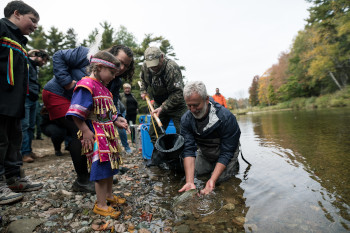
Adult salmon are being weighed, measured and sampled for monitoring by Kouchibouguac National Park biologists.
All about Atlantic salmon
What is being done to recover salmon populations and what are the benefits for the greater ecosystem?
Five national parks in Atlantic Canada are working together to protect salmon populations and answer large-scale questions about the contribution of salmon to our rivers, forests and oceans.Salmon and the ecosystem
Salmon are an anadromous species, meaning they migrate between freshwater and saltwater. This special feature makes salmon an important part of the forest, river and ocean ecosystems.
Born in the river, salmon spend their early years feeding and learning survival techniques that will help them throughout their life. Young fish feed on microscopic life and small invertebrates, both products of a healthy forest and river ecosystem.

Once the salmon have migrated to the ocean they are a food source for larger ocean creatures. The surviving salmon return to their rivers after spending between one to three years at sea.
These returning salmon transport marine-derived nutrients into the freshwater ecosystem. The nutrients enter freshwater by attaching to the salmon’s body in the form of slime and are left in the river or forest ecosystem when the fish spawn or are eaten. The nutrients left in the river and forest are important for maintaining healthy, balanced and productive ecosystems.
Cultural importance

Hundreds of years of human activity have created issues in freshwater and saltwater ecosystems that greatly impact Atlantic salmon across their range.
Atlantic salmon are very important to Indigenous communities in Eastern Canada.
Salmon have always been a significant part of many traditional practices and in the diet for local communities, even before European settlers came to Canada’s East Coast.
Following the arrival of Europeans, immigrants quickly made salmon a part of their diet, and angling became an enjoyable pastime.
The decline
As the human population and economic pressure increased during the late 1800s and early 1900s, so too did many unsustainable harvesting practices.
Overfishing, logging, farming and urbanization led to a decline in salmon and other fish species--along with an increase in stream bank erosion, sedimentation, and pollution.
Populations of salmon across the Atlantic dropped quickly and have never fully recovered. This is despite the modernization of many of these industries in the mid-1900s with the introduction of measures to end salmon harvests, remove dams and poor culverts, and change land use practises.
Salmon populations in many locations are now too small, and suffer too many obstacles, to recover without human intervention.

Building on success

The conservation actions being implemented at each park build on decades of collaborative salmon restoration within Parks Canada.
Conservation approaches which were proven in Fundy National Park and Terra Nova National Park will be modified and adapted for other national parks so that their populations recover before becoming endangered.
- Date modified :